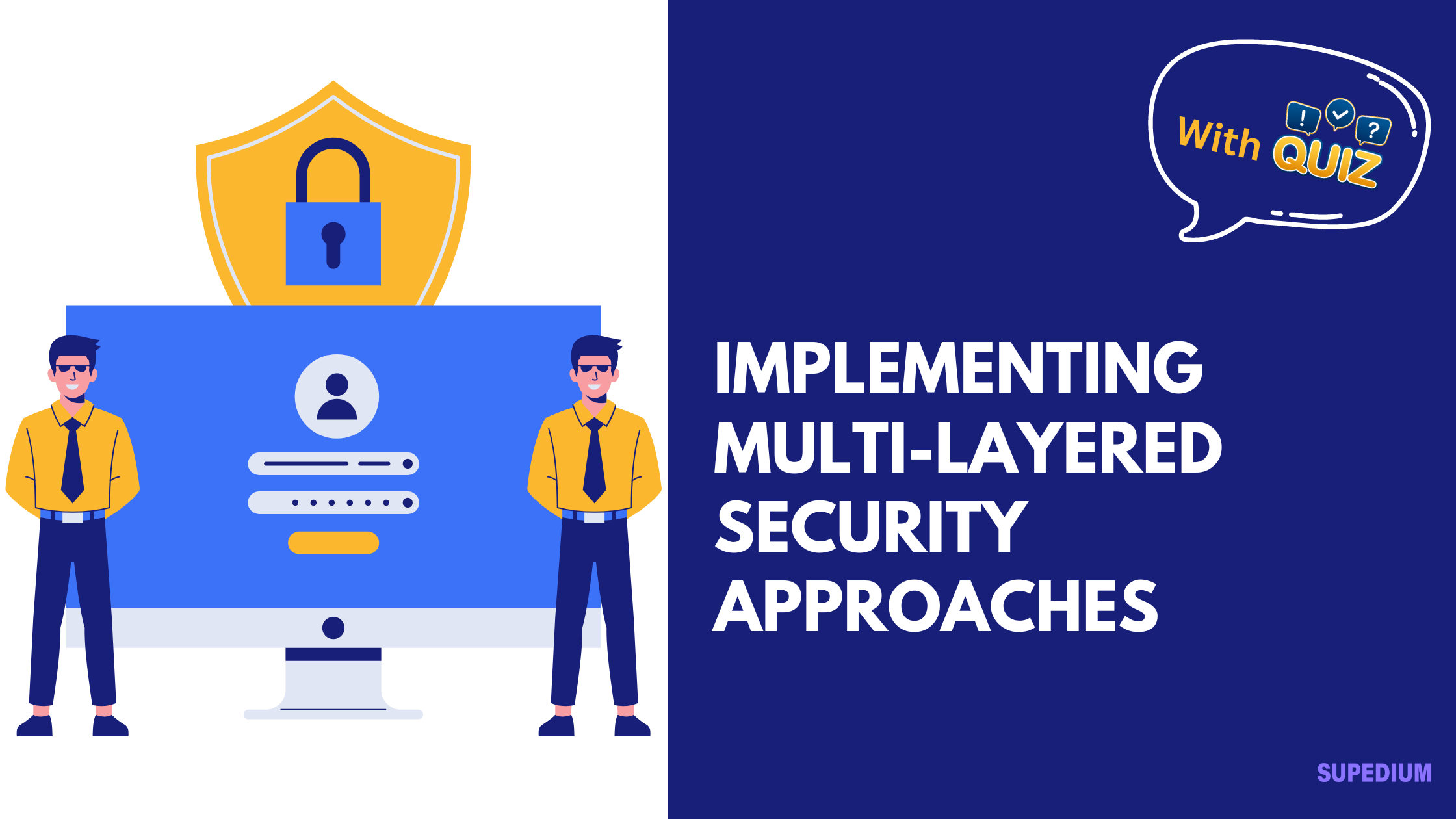Table of Contents
- 1 I. Introduction
- 2 II. Overview of Multi-Layered Security
- 3 III. Assessing Security Needs
- 4 IV. Designing a Multi-Layered Security Strategy
- 5 V. Implementation of Security Layers
- 6 VI. Monitoring and Maintenance
- 7 VII. Challenges in Implementing Multi-Layered Security
- 8 VIII. Case Studies
- 9 IX. Future Trends in Multi-Layered Security
- 10 X. Conclusion
- 11 Quiz Time
![]()
I. Introduction
In an era where cyber threats are becoming increasingly sophisticated, organizations must adopt robust security measures to protect their digital assets. Multi-Layered Security (MLS) is a strategic approach that combines multiple security measures across different layers to create a comprehensive defense mechanism. This article explores the importance of MLS, its components, and practical steps for implementation, aiming to equip organizations with the knowledge to enhance their security posture.
II. Overview of Multi-Layered Security
A. Concept and Principles of MLS
Multi-Layered Security is rooted in the concept of “defense in depth.” This principle asserts that relying on a single security measure is insufficient, as attackers often find ways to bypass it. By implementing multiple layers of security, organizations can create redundancies that bolster resilience against threats.
B. Key Components of MLS
- Physical Security: Protects the physical assets of an organization, including data centers and offices.
- Network Security: Safeguards the integrity of networks and the data transmitted across them.
- Endpoint Security: Focuses on securing end-user devices such as computers and mobile phones.
- Application Security: Ensures that applications are designed and maintained to be secure against threats.
- Data Security: Protects sensitive information from unauthorized access and breaches.
- User Security: Involves measures that protect users and their access to systems.
III. Assessing Security Needs
A. Identifying Assets and Vulnerabilities
A thorough assessment of an organization’s assets and vulnerabilities is the first step in implementing MLS. This includes creating an asset inventory and conducting vulnerability assessments to identify potential weaknesses.
B. Risk Assessment and Management
Risk assessment involves quantifying potential risks associated with various threats and prioritizing security measures accordingly. Organizations must consider factors such as the likelihood of an attack and the potential impact on operations.
C. Regulatory and Compliance Considerations
Organizations must also be aware of regulatory requirements relevant to their industry, ensuring that their security measures comply with standards such as GDPR, HIPAA, or PCI-DSS.
IV. Designing a Multi-Layered Security Strategy
A. Establishing a Security Framework
A solid security framework encompasses security policies, procedures, and governance structures. This framework sets the foundation for effective security management and oversight.
B. Integrating Various Security Layers
Integration is crucial for the effectiveness of MLS. Different security measures must work together seamlessly, allowing for enhanced threat detection and response capabilities.
C. Tailoring Security Measures to Specific Needs
Each organization has unique security needs. Tailoring security measures based on specific business requirements and risk profiles ensures that the approach is effective and efficient.
V. Implementation of Security Layers
A. Physical Security
- Access Control Systems: Implementing keycard or biometric access controls to restrict physical access to sensitive areas.
- Surveillance and Monitoring: Utilizing CCTV and security personnel to monitor physical premises.
- Environmental Controls: Protecting against environmental threats such as fire or flooding with appropriate controls.
B. Network Security
- Firewalls and Intrusion Detection Systems: Employing firewalls to block unauthorized access and intrusion detection systems to identify suspicious activities.
- Virtual Private Networks (VPNs): Encrypting internet traffic to secure remote connections.
- Secure Network Architecture: Designing networks to minimize vulnerabilities and optimize security.
C. Endpoint Security
- Antivirus and Anti-Malware Solutions: Deploying software to detect and mitigate malicious threats on endpoints.
- Patch Management: Regularly updating software to fix vulnerabilities and protect against exploits.
- Mobile Device Management: Securing mobile devices to prevent unauthorized access and data breaches.
D. Application Security
- Secure Coding Practices: Implementing coding standards that prioritize security during the development phase.
- Regular Application Testing and Assessments: Conducting penetration tests and security assessments to identify weaknesses.
- Application Firewalls: Protecting applications from web-based attacks.
E. Data Security
- Encryption Techniques: Encrypting sensitive data at rest and in transit to protect it from unauthorized access.
- Data Loss Prevention (DLP) Tools: Implementing solutions that monitor and protect data from unauthorized sharing or leaks.
- Backup and Recovery Strategies: Establishing robust backup procedures to ensure data can be restored in case of a breach.
F. User Security
- Identity and Access Management (IAM): Managing user identities and their access to resources to prevent unauthorized access.
- Multi-Factor Authentication (MFA): Implementing MFA to add an extra layer of security beyond passwords.
- Security Awareness Training: Regularly educating users about security best practices and potential threats.
VI. Monitoring and Maintenance
A. Continuous Monitoring and Threat Detection
Implementing Security Information and Event Management (SIEM) systems can help organizations continuously monitor for potential threats and anomalies.
B. Incident Response Planning
An effective incident response plan outlines how an organization will respond to security incidents, including the roles and responsibilities of team members and communication protocols.
C. Ongoing Training and Awareness Programs
Regular training ensures that employees remain informed about the latest threats and best practices, fostering a culture of security within the organization.
VII. Challenges in Implementing Multi-Layered Security
Implementing MLS can present challenges, including:
- Complexity and Resource Allocation: Managing multiple layers of security requires significant resources and expertise.
- Balancing Security with Usability: Striking a balance between robust security measures and user experience is crucial.
- Keeping Up with Evolving Threats: Cyber threats are continually evolving, necessitating adaptive security strategies.
- Compliance with Industry Standards: Ensuring compliance with relevant regulations can be complex and time-consuming.
VIII. Case Studies
A. Successful Implementation Examples
- Corporate Case Study: A financial institution successfully integrated MLS, resulting in a significant reduction in security incidents.
- Government Agency Case Study: A government agency implemented MLS to protect sensitive citizen data, enhancing public trust.
B. Lessons Learned from Security Breaches
- Analysis of Failures: Reviewing notable security breaches highlights vulnerabilities and areas for improvement.
- Recommendations for Improvement: Organizations can learn from these incidents to strengthen their own security measures.
IX. Future Trends in Multi-Layered Security
A. Emerging Technologies and Innovations
Technologies like Artificial Intelligence and machine learning are playing a pivotal role in enhancing threat detection and response capabilities.
B. Evolution of Cyber Threats
As cyber threats become more advanced, organizations must adapt their security measures to address new vulnerabilities.
C. Predictions for the Future of Security
The future of security will likely see an increased focus on Zero Trust architecture, emphasizing continuous verification and minimal trust assumptions.
X. Conclusion
The implementation of Multi-Layered Security approaches is essential for organizations aiming to protect their digital assets in an increasingly hostile cyber environment. By understanding the components, assessing security needs, and following a structured implementation process, organizations can significantly enhance their security posture. As cyber threats evolve, continuous adaptation and vigilance will be crucial in maintaining effective security measures.






Be the first to comment